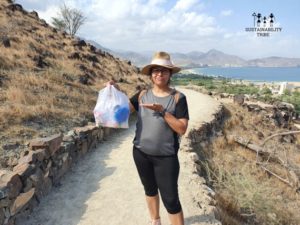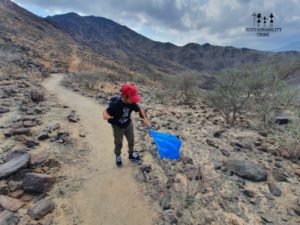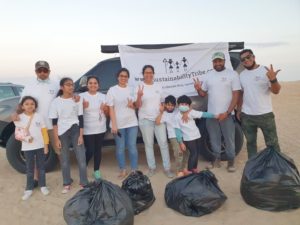Tribe, since the pandemic foreign travels, have been reduced and local travel has been popular around the world. More and more people have started visiting outdoors, where they are exploring natural beauty closer to their home. So much is this demand that around the world local governments or tourism industry has launched many new experiences of connecting people with nature be it hiking or tours. This is great news, as spending time outdoors boosts your health, read more about why you should go outdoors.
However, this new tourism to the local outdoors has also impacted the environment negatively to some extent because of a lack of awareness and education about how to be conscious when visiting local protected areas or national parks. During our Sustainable Tourism event last year, a virtual community event by Sustainability Tribe (watch the video recording here), one of our guest speakers was Marta Mills a sustainable tourism advisor who is also part of IUCN, WCPA, Tourism & Protected Areas Specialist Group. Marta pointed out how these new domestic tourists are not mindful when visiting outdoors. She shared an example from her advisory work, how in the Dolomites, people are visiting mountains in their flip flops and high heels, which may cause health and safety hazards. (read Martha’s one planet blog here).
One of the biggest and most visible negative impacts of this surge in outdoor activities is littering in previously pristine areas. Last year during our regular desert visits or hiking in the UAE’s Hajar mountains, I repeatedly came across littered garbage in very remote areas. As part of the family tradition at Sustainability Tribe HQ, for years we have been cleaning up during our every outdoor trip and travels. But since last year, I started posting about garbage littering and our routine cleanups on social media to bring social attention. And every time outdoor lovers from around the world like the UK, the US responded to Sustainability Tribe’s social media posts that they are seeing the same situation in their favorite outdoor locations. That being the case, we all need to start acting instead of complaining about this situation.

Cleanup on a hike
You might be a first-timer or a seasoned outdoorsy person; here is our simple guidebook for anyone who wants to venture outdoors, connect with nature, consciously.
Whenever you are deciding to visit an outdoors, close to nature place be it a National Park or mountains or secret beaches, the first thing you should do is research. It’s very important to step in to avoid some unpleasant surprises as well as for security and safety reasons. For example, if you are heading outdoors check the weather forecast in advance so that you are either prepared or avoid accidents like flash floods due to rains or high tide etc. If you have decided to camp overnight, you should also recce the location to see the suitability. Along with scouting the location, it’s also important to familiarize ourselves with these new surroundings in the daylight.

Camping on the beach
If you do the research in advance it also helps in packing suitable clothing, layers for the day trip. For example, talking about UAE’s deserts and mountains, it can get really chilly in the open areas than the city areas during our mild winters. Or if you are okay to enjoy some rain showers during your hikes, then at least you need to pack some rain cover for you and your bag or maybe dry bags for electronics. I also prefer packing my first aid kit when going outdoors or camping. You definitely learn as you start going on outdoor trips, but leaving home with adequate preparation is the first step for a successful and funfilled outdoor trip.
Leave nothing but footprints, is a very popular term when it comes to leaving our environment clean. But I feel this thought process should start when you are preparing and planning for your outdoor activities. And from my experience of zero waste travels, I can tell you, it’s not that hard. Here are some tips.

Garbage on mountain
When packing ready meals or barbeque foods, try packing them in lunch boxes instead of disposable packaging. You can easily pack your drinking water reusable bottles and tea coffee in a thermos flask. My go-to favorite snacks for our hiking trips are always bananas, oranges which you can simply peel and consume, and nuts which you can carry in small reusable containers or pouches. Another strategy can be if you need to buy ready foods or drinks like fizzy drinks, instead of single packets or cans, you can buy them in bulk to reduce the waste.
However, all these efforts will show great results only when you reduce disposable single-use items like cups, plates, cutleries, etc. Imagine if each one of the camper and hiker starts bringing their own reusable water bottle, plates, cutlery, and cup, we can reduce so much waste. All you need to do is give a quick rinse so that you can store them clean and reuse them again on the same trip. Read this article, what to pack in your bag to reduce single-use plastic waste.

Reusables
Many times, when going outdoors, people happily prepare and pack and sometimes even fill up their car boots. But when it comes to breaking camp and packaging up your picnic; people become lazy. They want to quickly wrap up and don’t want to have a lot of after-work because they want to get on with their routine quickly. So it’s important to plan your time to leave enough time to pack up and clean up your campsite or picnic spot before leaving. Plus leave enough time to do a little bit of washing up and cleaning up with your reusables at home. If we are spending days and hours outdoors and enjoying it then it’s also our duty to spend few extra minutes cleaning up to make sure next time we return we have the same beautiful natural landscape.
Let’s look at the consequences of littered garbage and related pollution. The waste littered in the great outdoors including deserts, mountains, beaches, parks, wetlands, mangroves, and forests contaminate our natural environment and ecosystem. This way we directly pollute our water, land, and air.

Typical littered waste in the desert
When the debris is thrown on the ground, it can easily get washed by stormwater and enter streams, rivers, lakes, and even groundwater. Most likely this debris chocks and suffocate water life like ducks, fish, turtles, and even birds. Or the waste degrades in water leach either chemicals or toxins in the water and plastic turns into microplastic, thus further polluting the water bodies and harm aquatic life.

Plastic bag flying off in a storm
The littered garbage also contaminates air, the microfibers are released from plastic that is breaking down, the toxins from waste are released contaminating air. During our nature excursions, I have even seen plastic bags flying off with the wind in the otherwise pristine landscape so many times. Just a simple change in habit can put an end to this grim picture of garbage littering in nature.
On the land, littered trash can contaminate soil and degrade it. Plus many animals and wildlife end up consuming rubbish and can die because of choking or starvation. Here in the UAE, many people have a misunderstanding that a desert is a barren place, but that’s not true, rather desert is a more fragile ecosystem than many other ecosystems. There are many wildlife, insects, bugs that thrive in the desert. We littering garbage makes it more difficult for these creatures to survive in this already harsh ecosystem. Watch this video, we made on world Environment Day 2020, where you can learn more about biodiversity in desert and desert clean-up.
One of the worst effects of littering and pollution is it also enters the food chain. We are familiar with ocean microplastic showing up on our plate via salt. But recently published the study ‘The Plight of Camels Eating Plastic Waste’ conducted by Dubai’s Central Veterinary Research Laboratory, analyzed 30,000 camels since 2008 and concluded camels are dying because of littered garbage in the desert.

When camel caravan visited our desert cleanup site
When camels graze in the desert, for them everything is food apart from sand grains. So right from plastic bottles to harder bottle caps and disposable plates to plastic bags, camels eat everything which is scattered in the desert along with desert vegetation. A lot of this indigestible waste is found in dead camel’s stomach, known as polybezoars. Littered garbage is not just threatening camels on land or fish in water; there are around 700 species that eat and get caught in plastic litter. Some of them are critically endangered species like locally found hawksbills turtle on verge of slowly getting vanished from the earth’s surface.
When we go outdoors, some of us feel adventurous and feel like exploring more. However, it’s important not to disturb natural systems and wildlife in natural and protected areas. Here are some of the things we can avoid. Going off the hiking trails is not good as it can damage delicate flora and fauna. Another danger of going off the hiking trail especially in the local region is accidents because of loose rocks.

Ruhaan is cleaning up during a hike
Lately, so many natural locations are getting popular around the world, because they are Instagramable. But overcrowding natural places can cause disruption of wildlife, so better to avoid it as much as possible. On a side note, be mindful when taking photos on the edge of a cliff, your life is worth more than a selfie!
Leaving food waste behind thinking animals will eat (especially the cooked food) is not a good idea, similar to feeding bread to ducks. As this can imbalance animal diet, our fatty food can also cause harm to their digestion system.
The rule for natural water bodies, don’t wash your plates, clothes or swim in protected pools. This can cause great damage to some rare aquatic species in these isolated water bodies. An example in UAE is Wadi Wurayah national park, which is home to rare and endangered species.
Off-road driving is great fun, but it’s better to do it in designated or limited areas instead of going deeper in the desert. Off-road driving can cause damaging burrows and nests of desert wildlife as well as damage fragile flora, fauna that are thriving in the harsh ecosystem. Read here our guide to UAE’s wadis.
It’s also not a good idea to cut down trees for a campfire. Or collect a lot of seashells from the beach, as the shells are important elements in the beach ecosystem. Here is UAE’s specific guide about how to help to conserve UAE’s wildlife?.
Hoping these tips will help our readers learning some basic outdoor etiquette and inspire preserving nature while enjoying it!
Next time you are going outdoors, spot a garbage bin and remember the location so that you know where to bring back your garbage, do not litter! Also, highly recommend cleaning up the spot where you rested, had a picnic, or camped even if it’s not your garbage, help conserving Nature with your small actions and bring a bigger impact!

Sustainability Tribe Clean-Up Drive
We are soon going to organize a special desert cleanup drive for our Ambassador Program participants, so take a sustainability challenge and join the program soon. ST Ambassador is a reward-based social education program, free for everyone.

Amruta Kshemkalyani, an expert sustainability professional turned social entrepreneur, is the founder of the Sustainability Tribe, AK Sustainability
Read More >>
Copyright 2024 © Sustainability Tribe, Registered under 'Sustainability Tribe Marketing Management' in the U.A.E., Design by LBM INFOTECH